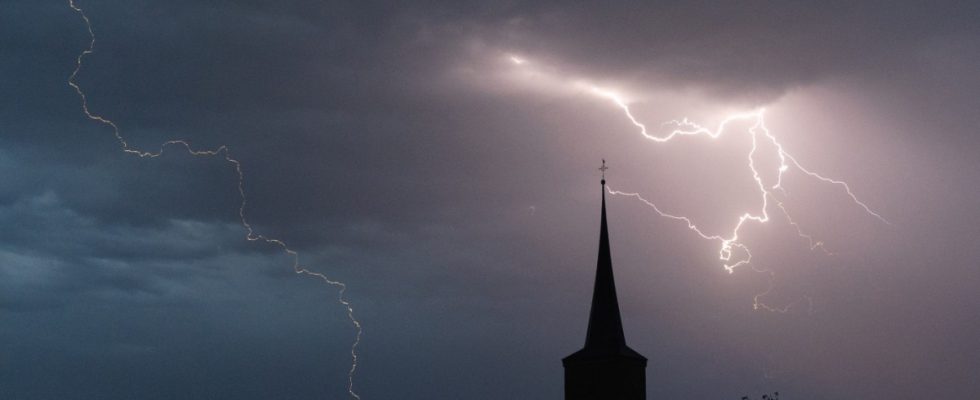There were 242,421 flashes in Germany last year. That was only half as often as a year earlier and less than it has been for 30 years, as the lightning information service from Siemens (Blids) recorded for the year 2022. Its manager, Stephan Thern, makes the drought a major reason for the numbers.
“In the summer, especially in July and August, there was sometimes extreme drought with high temperatures of over 35 degrees,” said Thern. “But thunderstorms require both: moisture and hot temperatures.” According to the German Weather Service (DWD), the summer of 2022 was one of the driest since records began.
Typically, the main thunderstorm season falls in the summer months. The month with the most lightning in 2022 was June, which had not yet been slowed down by a severe drought, with 65,969 lightning strikes nationwide. In July 2022, however, the system only counted 31,040 lightning strikes across Germany, less than a third of the value from the previous year.
The DWD also emphasizes that the number of thunderstorms and lightning is mainly due to the drought. “It goes hand in hand,” said a spokesman in an interview with the Süddeutsche Zeitung. Global warming is also a factor. “If there are thunderstorms, they will be more violent,” said the DWD spokesman.
Lightning strikes most frequently in southern Germany
According to the Siemens data, the Bavarian town of Kempten leads the German Blitz ranking. With 2.45 strikes per square kilometer, the highest lightning density of all rural districts, districts and urban districts in Germany was recorded there. However, this is comparatively little. In 2021, the value would only have been enough for place 58 – the then lightning hotspot Starnberg was more than three times as much.
At the other end of the scale are the cities of Brandenburg an der Havel with 0.04 and Hof with 0.07 flashes per square kilometer – respectively only 10 and 4 flashes per year.
According to the DWD, it is not unusual that the statistics for the mountainous south of Germany are higher. “It’s easier for storm clouds to form there,” said the DWD spokesman, because there were stronger updrafts.
Baden-Württemberg had the highest lightning density of all federal states with 0.97 flashes per square kilometer ahead of Bavaria with 0.85 and Hamburg with 0.81. The lowest values were in Thuringia with 0.39, Bremen with 0.41 and Saxony-Anhalt and North Rhine-Westphalia with 0.43 each.
With an average of 0.7 lightning strikes per square kilometer, the Federal Republic is in the middle compared to its neighbors. In 2022, the highest lightning densities in Europe were recorded in Montenegro, Bosnia-Herzegovina and Slovenia. The lowest were in Ireland. In Montenegro, there was an average of more than six times as much lightning as in Germany.
Less lightning also means less damage
Due to the comparatively small number of lightning strikes, the damage caused by them also decreased in 2022, albeit not quite as significantly. The General Association of the German Insurance Industry counted 160,000 lightning and overvoltage damage cases with insured losses amounting to 170 million euros. That was 50,000 claims and 40 million euros less than in 2021.
For this summer, the German Weather Service sees a different weather situation than last year. Especially in the past few weeks, there have been repeated storms and thunderstorms. In June there was regional heavy rain or extreme drought, writes the DWD in a press release. In July, there were daily showers, thunderstorms and heavy rain, especially in the last week of the month. Compared to the period from 1961 to 1990, there was even 30 percent more precipitation.
A team of atmospheric scientists and statisticians from the University of Innsbruck was able to study from this year show that lightning activity in the high Alps has roughly doubled in recent years compared to the 1980s. Especially in June – generally the month with the strongest risk of thunderstorms – the probability of getting caught in a storm while hiking in the Alps has increased significantly. At the same time, the thunderstorm season, which typically runs from May to September, has lengthened somewhat.
The lightning information service from Siemens locates thunderbolts in several European countries and, according to the company, makes the data available to weather services, companies, industry and insurance companies. More than 155 measuring stations in Europe are used for this, which can locate lightning strikes with an accuracy of up to 50 meters. The knowledge gained would also quickly be used to create warnings for thunderstorms, says the service’s website. The measurements have been carried out since 1991.

